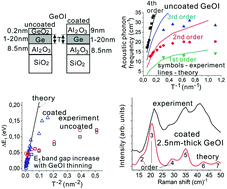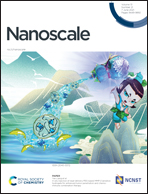Optical study of electron and acoustic phonon confinement in ultrathin-body germanium-on-insulator nanolayers†
Abstract
Nanoelectronics require semiconductor nanomaterials with high electron mobility like Ge nanolayers. Phonon and electron states in nanolayers undergo size-dependent changes induced by confinement and surface effects. Confined electrons and acoustic phonons determine layer optical, electric and thermal properties. Despite scientific and practical significance, their experimental studies in individual nanolayers are still lacking. Thanks to recent progress in the fabrication of high-quality nanolayers, here, we report the thickness dependencies of Raman spectra of acoustic phonons and optical spectra of electrons confined in germanium-on-insulator (GeOI) nanolayers with thicknesses TGeOI = 1–20 nm. We show that for TGeOI > 5 nm, both GeOI acoustic phonon Raman spectra and the E1 electron energy gap display dependencies on TGeOI which are reasonably described by the corresponding phonon and electron confinement theories. Accordingly, TGeOI can be probed using acoustic phonon Raman spectra at TGeOI > 5 nm. However, both confinement theories fail to describe GeOI thickness dependencies at TGeOI < 5 nm. We attribute this discrepancy to an increased influence of the Ge–GeO2 interface disorder with TGeOI reduction. The acoustic phonon data suggest a decrease of Ge normal-to-the-layer longitudinal sound velocity. Generation of interface-disorder-induced dispersionless phonons might contribute to this. The change in GeOI phonon properties at TGeOI < 5 nm might influence E1(TGeOI) dependence via a change in the GeOI electron–phonon interaction. We demonstrate that the Al2O3 coating improves the agreement between experimental and confinement theories, probably, via reduction of disorder at the Ge–GeOx–Al2O3-interface. Our results are important for control of nanolayer-confined electrons and phonons with benefits for modern and future nanoelectronic devices.



 Please wait while we load your content...
Please wait while we load your content...